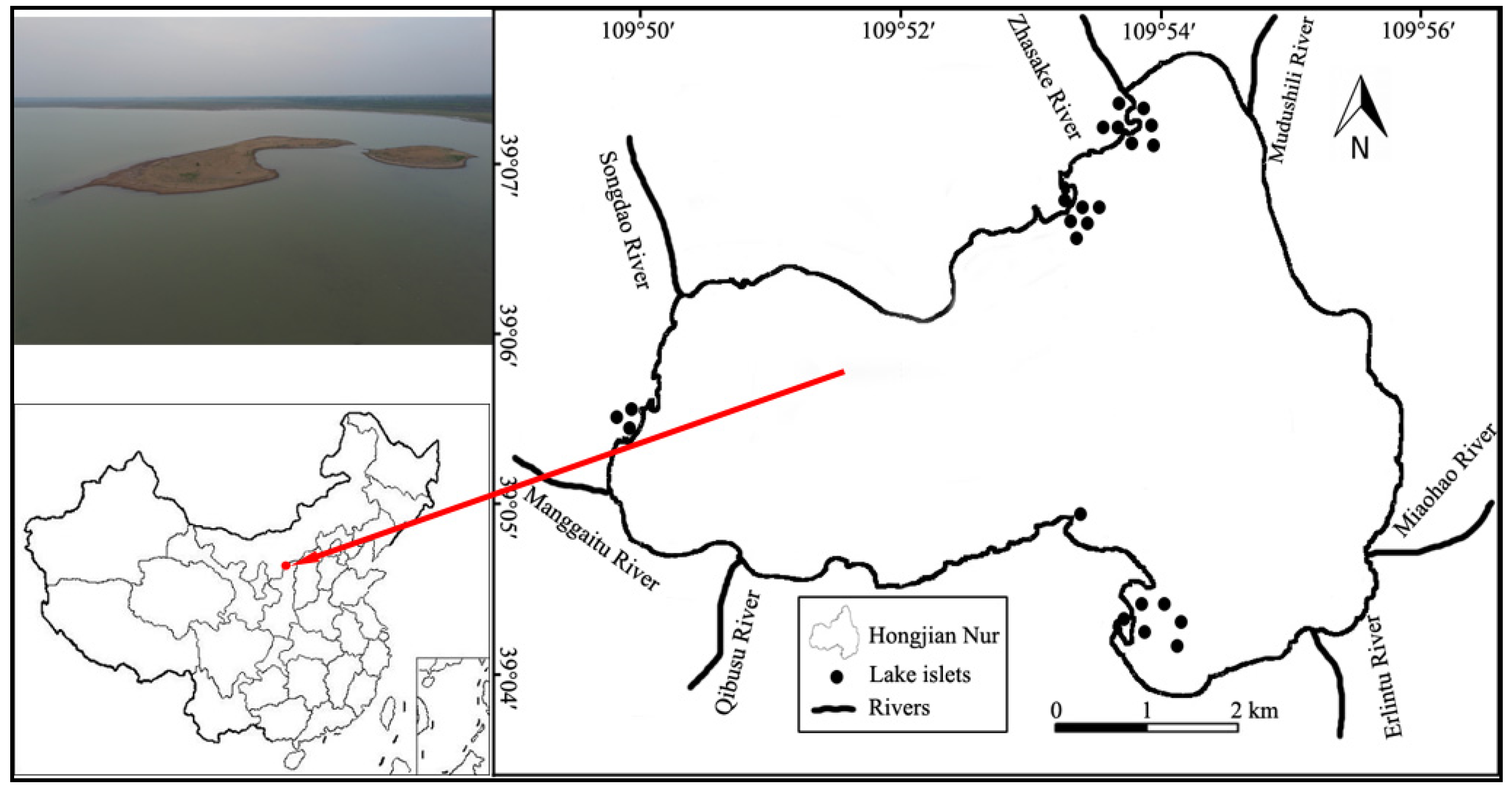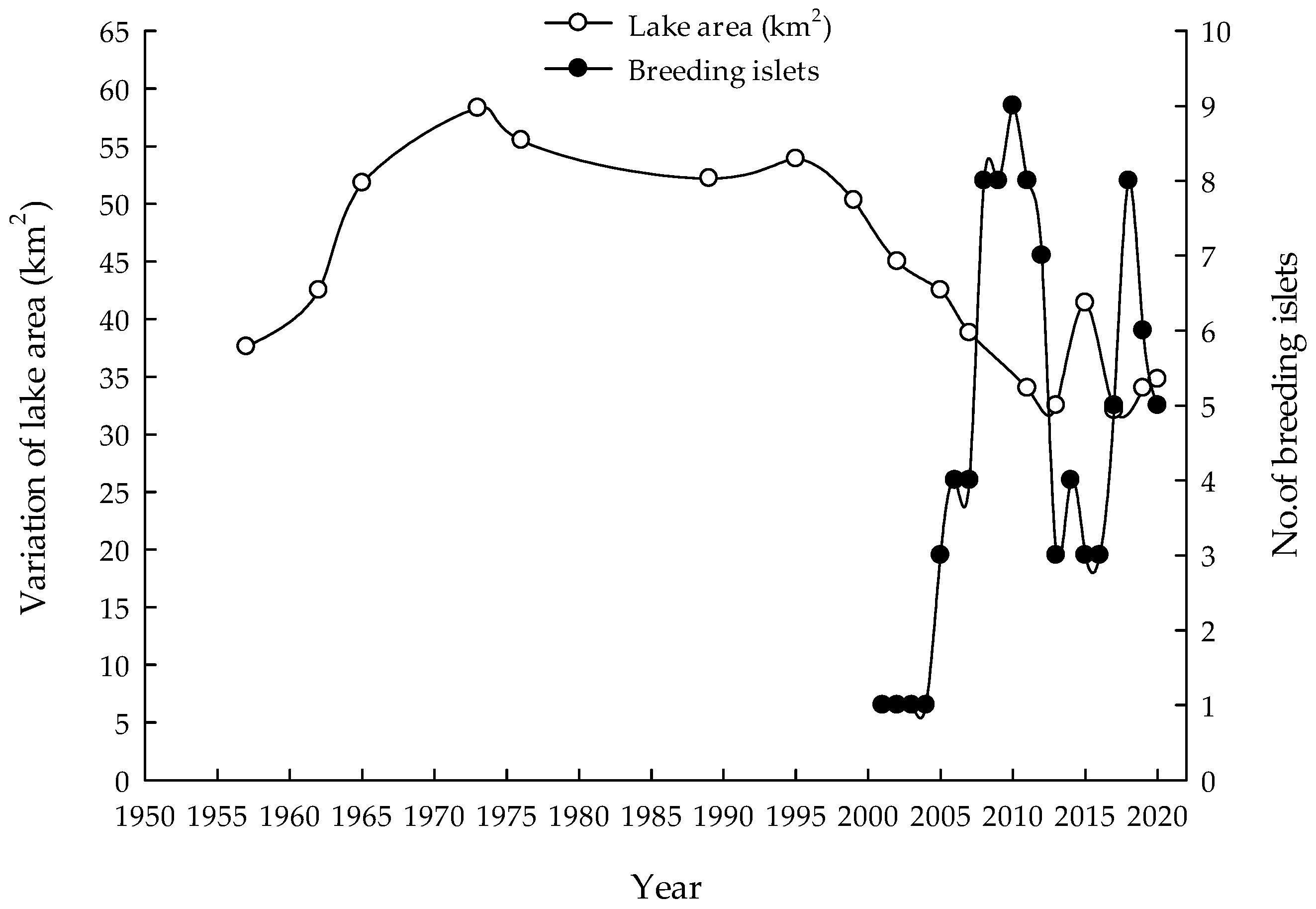Breeding Population Dynamics of Relict Gull (Larus relictus) in Hongjian Nur, Shaanxi, China
Abstract
:Simple Summary
Abstract
1. Introduction
2. Materials and Methods
2.1. Study Area
2.2. Data on Relict Gull Breeding Population
2.3. Statistical Analysis
3. Results
3.1. Breeding Population Dynamics
3.2. Reproductive Success
3.3. Variation of Lake Area and Breeding Islets Transition
4. Discussion
5. Conclusions
Author Contributions
Funding
Institutional Review Board Statement
Informed Consent Statement
Data Availability Statement
Acknowledgments
Conflicts of Interest
References
- Virkkala, R. Spatiotemporal variation of breeding gull species in a boreal lake complex in Finland: Implications for conserva-tion. Biol. Conserv. 2006, 128, 447–454. [Google Scholar] [CrossRef]
- Perrins, C.M.; Lebreton, J.-D.; Hirons, G.J.M. Bird Population Studies: Relevance to Conservation and Management; Oxford University Press: New York, NY, USA, 1991; pp. 1–683. [Google Scholar]
- Sullivan, M.; Newson, S.E.; Pearce-Higgins, J.W. Using habitat-specific population trends to evaluate the consistency of the effect of species traits on bird population change. Biol. Conserv. 2015, 192, 343–352. [Google Scholar] [CrossRef]
- Stodola, K.W.; Ward, M.P.; Uy, J.A.C.; Winn, A.A. The Emergent Properties of Conspecific Attraction Can Limit a Species’ Ability to Track Environmental Change. Am. Nat. 2017, 189, 726–733. [Google Scholar] [CrossRef] [PubMed] [Green Version]
- Ulfvens, J. Population and colony site dynamics in black-headed gulls Larus ridibundus breeding on the Finnish west coast. Ornis Fennica. 1993, 70, 96–101. [Google Scholar]
- Jenouvrier, S. Impacts of climate change on avian populations. Glob. Chang. Biol. 2013, 19, 2036–2057. [Google Scholar] [CrossRef] [Green Version]
- Kilpi, M. Breeding success, predation and local dynamics of colonial common gulls Larus canus. Ann. Zool. Fenn. 1995, 32, 175–182. [Google Scholar]
- Nur, N.; Sydeman, W.J. Survival, breeding probability and reproductive success in relation to population dynamics of Brandt’s CormorantsPhalacrocoraxpenicillatus. Bird Study 1999, 46, S92–S103. [Google Scholar] [CrossRef]
- Mischler, C.P. Estimationg the breeding population of black-billed gulls Larus bulleri in New Zealand and methods for future cont surveys. Motornis 2018, 65, 67–83. [Google Scholar]
- Baasch, D.M.; Hefley, T.J.; Cahis, S.D. A comparison of breeding population estimators using nest and brood monitoring data. Ecol. Evol. 2015, 5, 4197–4209. [Google Scholar] [CrossRef]
- Nadal, J.; Ponz, C.; Margalida, A. Population age structure as an indicator for assessing the quality of breeding areas of Common quail (Coturnix coturnix). Ecol. Indic. 2018, 93, 1136–1142. [Google Scholar] [CrossRef]
- Zheng, G.M.; Wang, Q.S. China Red Book of Endangered Species (Aves); Science Press: Beijing, China, 1998; pp. 240–241. [Google Scholar]
- IUCN. IUCN Red List of Threatened Species. Available online: www.iucnredlist.org (accessed on 17 May 2019).
- Jiang, Z.G. China’s Red List of Biodiversity: Vertebrates; Zhang, Y.Y., Zheng, G.M., Eds.; Science Press: Beijing, China, 2021; Volume II, pp. 128–129. [Google Scholar]
- BirdLife International Species Factsheet: Larus relictus. Available online: http://datazone.bird-life.org/species/factsheet/relict-gull-larus-relictus (accessed on 10 August 2019).
- CITES. CITES Home Page. Available online: https://checklist.cites.org (accessed on 5 March 2022).
- Collar, N.J.; Crosby, M.J.; Stattersfield, A.J. Birds to Watch 2: The World List of Threatened Birds; BirdLife International: Cambridge, UK, 1994. [Google Scholar]
- He, F.Q.; David, M.; Xing, X.J.; Ren, Y.Q. A review on studies of the Relict gull Larus relictus. Chin. J. Zool. 2002, 37, 365–370. [Google Scholar]
- Xu, Z.W. Recent records of the Relict gull Larus relictus in Shaanxi Province. Chin. J. Wildlife 2001, 22, 39. [Google Scholar]
- Xiao, H.; Wang, Z.Q.; Hu, C.E.; Wang, Y. Relict gull Larus relictus breeding population dynamics and their breeding habitat in Hongjian Nur, Shaanxi Province. Sci. Rev. 2008, 26, 1454–1457. [Google Scholar]
- Ma, H.L.; Bai, M.; Guo, Y. Analysis on the space-time evolvement process and cause of Hongjiannao during 1957 and 2019. Geo. Spat. Inf. Technol. 2020, 43, 143–146. [Google Scholar]
- Wu, Y.; Zhang, H.; Zhang, Y.Q.; Deng, L.; Hong, J.M. New breeding distribution of the Relict gull at Kangba Noel national wetland park in Zhangjiakou, Hebei Province. Chin. J. Zool. 2016, 51, 668–670. [Google Scholar]
- Gao, L.J.; Hou, J.H.; Dong, J.X.; Chen, C.; Du, M.T. New distribution of the Relict Gulls in breeding season-Aotai lake of Inner Mongolia. Chin. J. Zool. 2013, 48, 141–142. [Google Scholar]
- Xiao, H.; Wang, K.F.; Feng, N.; Xu, Z.Q. New breeding distribution of Relict Gulls in Gouchi wetland, Dingbian, Shaanxi Province. Chin. J. Zool. 2013, 48, 776–777. [Google Scholar]
- Zhai, H.; Yu, H.X.; Ma, G.D.; Wei, H.; Li, Y.L.; Feng, Q.D. A new record of Relict gull in Ningxia and its breeding population and breeding sites. Chin. J. Zool. 2019, 40, 196–199. [Google Scholar]
- Ren, Y.Q.; He, F.Q. A new breeding site of the Ordos breeding subpopulation for Relict gull in Chahan Nur, Inner Mongolia. Wetl. Sci. Manag. 2015, 3, 63. [Google Scholar]
- Zhao, N.; Ma, C.; Yang, Y.L. Water quality variation of lake Hongjiannao and its driving force analysis from 1973 to 2013. J. Lake. Sci. 2016, 28, 982–993. [Google Scholar]
- Wang, Y.; Yan, Z.L.; Gao, F. Monitoring spatio-temporal changes of water area in Hongjiannao lake from 1957–2015 and its driving forces analysis. Trans. Chin. Soc. Agri. Eng. 2018, 34, 265–271. [Google Scholar]
- Velarde, E. Breeding biology of Heermann’s Gulls on Isla Rasa gulf of Califormnia, Mexico. Auk 1999, 116, 513–519. [Google Scholar] [CrossRef]
- Keitt, T.H.; Stanley, H.E. Dynamics of North American breeding bird populations. Nature 1998, 393, 257–260. [Google Scholar] [CrossRef]
- Hanski, I.; Foley, P.; Hassell, M. Random walks in a metapopulation: How much density dependence is necessary for long-term persistence? J. Anim. Ecol. 1996, 25, 274–282. [Google Scholar] [CrossRef]
- Rebstock, G.A.; Boersma, P.D.; García-Borboroglu, P. Changes in habitat use and nesting density in a declining seabird colony. Popul. Ecol. 2015, 58, 105–109. [Google Scholar] [CrossRef]
- Wiltermuth, M.T.; Anteau, M.; Sherfy, M.H.; Pearse, A. Habitat selection and movements of Piping Plover broods suggest a tradeoff between breeding stages. J. Ornithol. 2015, 156, 999–1013. [Google Scholar] [CrossRef]
- Dreitz, V.J. Parental behavior of a precocial species: Implications for juvenile survival. J. Appl. Ecol. 2009, 46, 870–878. [Google Scholar] [CrossRef] [Green Version]
- Pöysä, H.; Elmberg, J.; Sjöberg, K.; Nummi, P. Nesting mallards (Anas platyrhynchos) forecast brood-stage food limitation when selecting habitat: Experimental evidence. Oecologia 2000, 122, 582–586. [Google Scholar] [CrossRef]


| Year | Clutch Size | Breeding Pairs (Nests) | MCZ | HS | FS | ||||
|---|---|---|---|---|---|---|---|---|---|
| 1 | 2 | 3 | 4 | 5 | |||||
| 2001 | 5 | 64 | 15 | 3 | 0 | 87 | 2.18 | 85.1% | 68.9% |
| 2002 | 11 | 170 | 42 | 8 | 0 | 231 | 2.20 | 87.4% | 66.3% |
| 2003 | 22 | 792 | 858 | 24 | 0 | 1696 | 2.52 | 87.9% | 61.0% |
| 2004 | 61 | 1045 | 1267 | 36 | 0 | 2409 | 2.53 | 90.3% | 62.4% |
| 2005 | 72 | 962 | 1371 | 55 | 0 | 2460 | 2.57 | 91.2% | 65.1% |
| 2006 | 498 | 1761 | 700 | 26 | 0 | 2985 | 2.09 | 84.6% | 65.9% |
| 2007 | 779 | 2399 | 1816 | 42 | 0 | 5036 | 2.22 | 87.8% | 67.8% |
| 2008 | 334 | 1494 | 1896 | 61 | 0 | 3785 | 2.44 | 89.3% | 60.7% |
| 2009 | 447 | 1771 | 1958 | 88 | 3 | 4267 | 2.40 | 88.3% | 63.3% |
| 2010 | 581 | 3163 | 3920 | 43 | 1 | 7708 | 2.44 | 89.5% | 62.4% |
| 2011 | 627 | 2397 | 4515 | 61 | 4 | 7604 | 2.53 | 95.4% | 69.6% |
| 2012 | 559 | 1963 | 2562 | 52 | 4 | 5140 | 2.41 | 88.5% | 63.2% |
| 2013 | 310 | 1367 | 2820 | 47 | 1 | 4545 | 2.57 | 90.9% | 69.2% |
| 2014 | 464 | 1967 | 1919 | 23 | 0 | 4373 | 2.34 | 87.6% | 64.2% |
| 2015 | 228 | 708 | 1081 | 37 | 0 | 2054 | 2.45 | 89.9% | 74.7% |
| 2016 | 465 | 1102 | 1038 | 9 | 0 | 2614 | 2.23 | 87.4% | 64.8% |
| 2017 | 270 | 839 | 1606 | 36 | 3 | 2754 | 2.51 | 95.1% | 65.9% |
| 2018 | 112 | 286 | 2266 | 33 | 6 | 2703 | 2.83 | 97.6% | 65.3% |
| 2019 | 251 | 743 | 2507 | 68 | 12 | 3581 | 2.68 | 96.7% | 67.3% |
| 2020 | 195 | 728 | 1215 | 14 | 1 | 2153 | 2.49 | 86.4% | 66.1% |
Publisher’s Note: MDPI stays neutral with regard to jurisdictional claims in published maps and institutional affiliations. |
© 2022 by the authors. Licensee MDPI, Basel, Switzerland. This article is an open access article distributed under the terms and conditions of the Creative Commons Attribution (CC BY) license (https://creativecommons.org/licenses/by/4.0/).
Share and Cite
Wang, Q.; Yang, C.; Hu, D.; Xiao, H.; Zhang, D. Breeding Population Dynamics of Relict Gull (Larus relictus) in Hongjian Nur, Shaanxi, China. Animals 2022, 12, 1035. https://doi.org/10.3390/ani12081035
Wang Q, Yang C, Hu D, Xiao H, Zhang D. Breeding Population Dynamics of Relict Gull (Larus relictus) in Hongjian Nur, Shaanxi, China. Animals. 2022; 12(8):1035. https://doi.org/10.3390/ani12081035
Chicago/Turabian StyleWang, Qingxiong, Chao Yang, Defu Hu, Hong Xiao, and Dong Zhang. 2022. "Breeding Population Dynamics of Relict Gull (Larus relictus) in Hongjian Nur, Shaanxi, China" Animals 12, no. 8: 1035. https://doi.org/10.3390/ani12081035
APA StyleWang, Q., Yang, C., Hu, D., Xiao, H., & Zhang, D. (2022). Breeding Population Dynamics of Relict Gull (Larus relictus) in Hongjian Nur, Shaanxi, China. Animals, 12(8), 1035. https://doi.org/10.3390/ani12081035






